My friend Rick Brookhiser recently posed this memeworthy notion: “It would make an exercise to say what are your least favorite works by artists you mostly, or sometimes, love.” So it would, and I’ve been thinking it over ever since. Here’s my Top (or Bottom) Five:
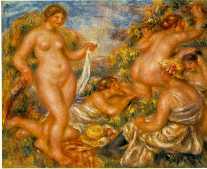 • Pierre-Auguste Renoir was a very great artist who painted far more than his share of very bad pictures, from the insipid young girls of his middle years to the deliquescent nudes of his old age. My first visit to the Barnes Collection, which owns more second- and third-rate Renoirs than any other museum in the world, was alarmingly instructive in this regard. To be sure, the competition is stiff, but the 1918 Bathers that I saw there in 2005 was without a doubt the worst Renoir that I’ve ever seen anywhere.
• Pierre-Auguste Renoir was a very great artist who painted far more than his share of very bad pictures, from the insipid young girls of his middle years to the deliquescent nudes of his old age. My first visit to the Barnes Collection, which owns more second- and third-rate Renoirs than any other museum in the world, was alarmingly instructive in this regard. To be sure, the competition is stiff, but the 1918 Bathers that I saw there in 2005 was without a doubt the worst Renoir that I’ve ever seen anywhere.
• Yes, Antony Tudor was a great choreographer–sometimes–but I confess without the slightest reluctance that Pillar of Fire, his heavy-breathing, deadly serious 1942 dance version of Schoenberg’s Verklärte Nacht, makes me giggle.
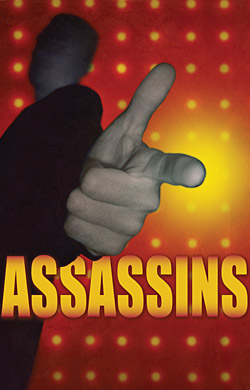 • My admiration for Stephen Sondheim is no secret to regular readers of this blog, but some of his musicals are better than others, and Assassins, in which he seeks to prove the essential falsehood of the American dream by portraying a group of successful and would-be presidential assassins, seems to me to be flawed beyond repair.
• My admiration for Stephen Sondheim is no secret to regular readers of this blog, but some of his musicals are better than others, and Assassins, in which he seeks to prove the essential falsehood of the American dream by portraying a group of successful and would-be presidential assassins, seems to me to be flawed beyond repair.
I wrote a review of the 2004 Broadway revival in which I summed up my reservations: “Do the lives of these misfits have any larger meaning? Perhaps, but you can’t prove it by Assassins, which merely asserts their significance rather than demonstrating it–and that’s where the show runs off the road. To be effective, political theater must deal in fact, not fancy, and most of America’s presidential assassins were in fact driven not by ideology but madness. Assassins leaves no doubt of that, especially in ‘The Ballad of Guiteau,’ in which Charles Guiteau, who shot and killed James Garfield, displays his megalomania to spectacular effect. And what do such delusions tell us about the validity of the American dream? Nothing, which is why Assassins makes no sense.”
• Howard Hawks was one of Hollywood’s greatest directors, but when he was bad, he was perfectly awful, and I’d be hard pressed to think of a lamer Hawks comedy than Man’s Favorite Sport? It’s not the worst movie he ever made–that would be Red Line 7000–but it’s bad enough to briefly make you wonder what you ever saw in him.
• “There are some sacrifices which should not be demanded twice of any man,” George Bernard Shaw wrote, “and one of them is listening to Brahms’ Requiem.” I’m with him, and then some. It’s been a quarter-century or so since I last sat through a complete performance of A German Requiem, and I hope and expect to go to my grave without voluntarily hearing that ponderous piece of musical mortuary science again.
Over to you, OGIC and CAAF.

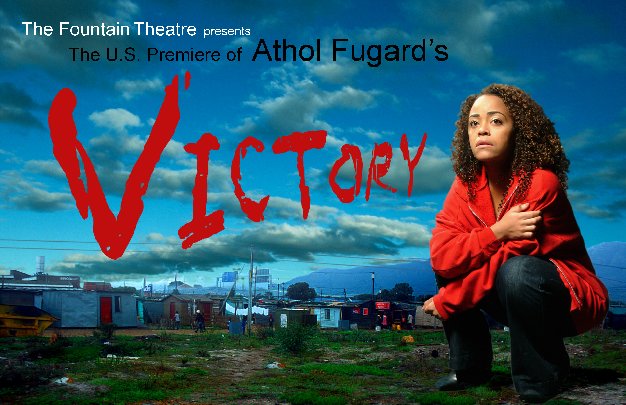 Athol Fugard wondered for a time whether the ending of apartheid in South Africa might also put an end to his playwriting career. Most of his best-known works, starting with “Blood Knot,” the 1961 two-man play that brought him worldwide acclaim, had been set against the brutal backdrop of the racial segregation that the white minority of his native land imposed on its black majority in 1948. Would Mr. Fugard have anything of equal interest to say about the new South Africa brought into being by the demise of apartheid–and would that long-awaited deliverance from evil turn his older plays into stale period pieces? The answers can be found in two productions now playing on the West Coast, the American Conservatory Theater’s San Francisco revival of “Blood Knot” and the American premiere of “Victory,” Fugard’s latest play, which is being presented not on Broadway but in a tiny theater located in–of all places–Hollywood.
Athol Fugard wondered for a time whether the ending of apartheid in South Africa might also put an end to his playwriting career. Most of his best-known works, starting with “Blood Knot,” the 1961 two-man play that brought him worldwide acclaim, had been set against the brutal backdrop of the racial segregation that the white minority of his native land imposed on its black majority in 1948. Would Mr. Fugard have anything of equal interest to say about the new South Africa brought into being by the demise of apartheid–and would that long-awaited deliverance from evil turn his older plays into stale period pieces? The answers can be found in two productions now playing on the West Coast, the American Conservatory Theater’s San Francisco revival of “Blood Knot” and the American premiere of “Victory,” Fugard’s latest play, which is being presented not on Broadway but in a tiny theater located in–of all places–Hollywood.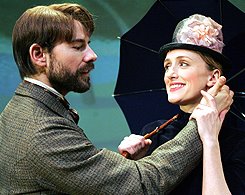 The original Broadway production of “Sunday in the Park with George” ran for 604 performances and won 10 Tonys and a Pulitzer Prize, but the show itself remains one of Stephen Sondheim’s problem children. The first act, a fictionalized re-creation of the making of “A Sunday Afternoon on the Island of La Grande Jatte,” Georges Seurat’s 1886 pointillist masterpiece, is itself a masterpiece of musical theater, a light-textured yet profound parable of the mystery of creation and the self-imposed, single-minded isolation of the creative artist. Not so the second act, in which Mr. Sondheim and James Lapine tell a parallel tale of the modern-day art world that lapses into the same cloying sententiousness that mars the second act of “Into the Woods,” their 1987 fairy-tale musical: Anything you do,/Let it come from you./Then it will be new.
The original Broadway production of “Sunday in the Park with George” ran for 604 performances and won 10 Tonys and a Pulitzer Prize, but the show itself remains one of Stephen Sondheim’s problem children. The first act, a fictionalized re-creation of the making of “A Sunday Afternoon on the Island of La Grande Jatte,” Georges Seurat’s 1886 pointillist masterpiece, is itself a masterpiece of musical theater, a light-textured yet profound parable of the mystery of creation and the self-imposed, single-minded isolation of the creative artist. Not so the second act, in which Mr. Sondheim and James Lapine tell a parallel tale of the modern-day art world that lapses into the same cloying sententiousness that mars the second act of “Into the Woods,” their 1987 fairy-tale musical: Anything you do,/Let it come from you./Then it will be new.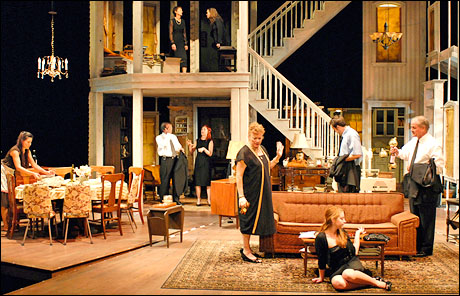 •
•